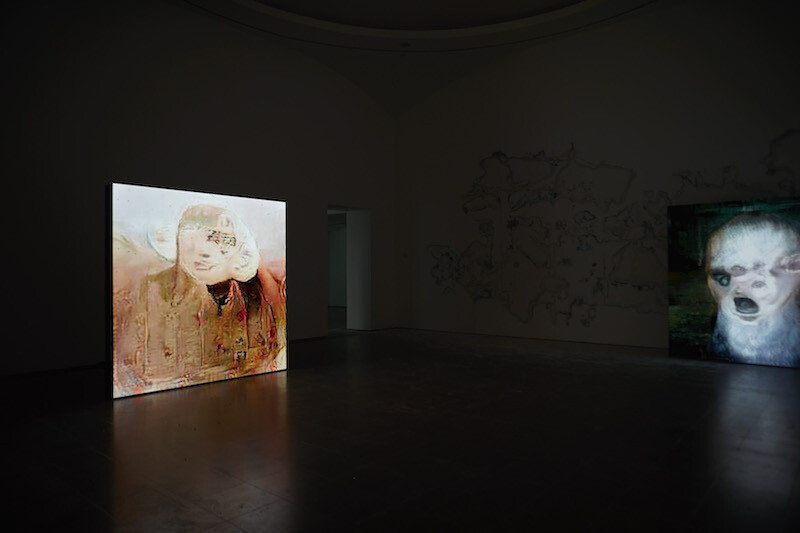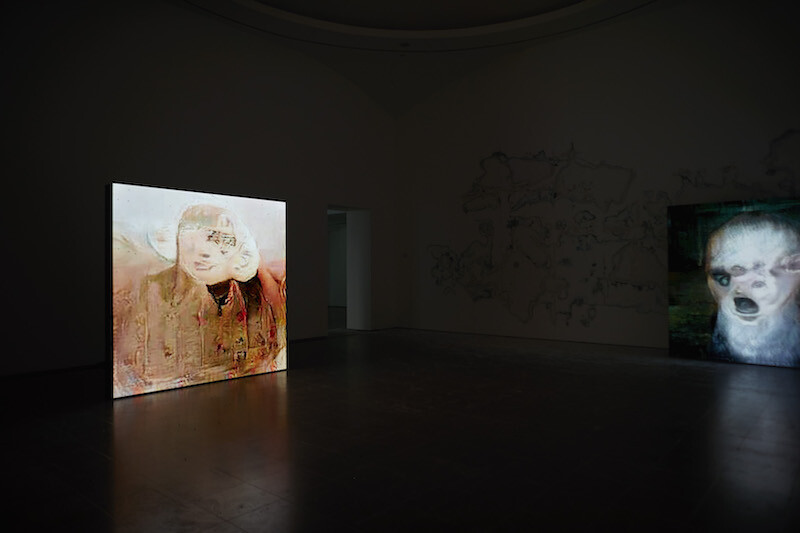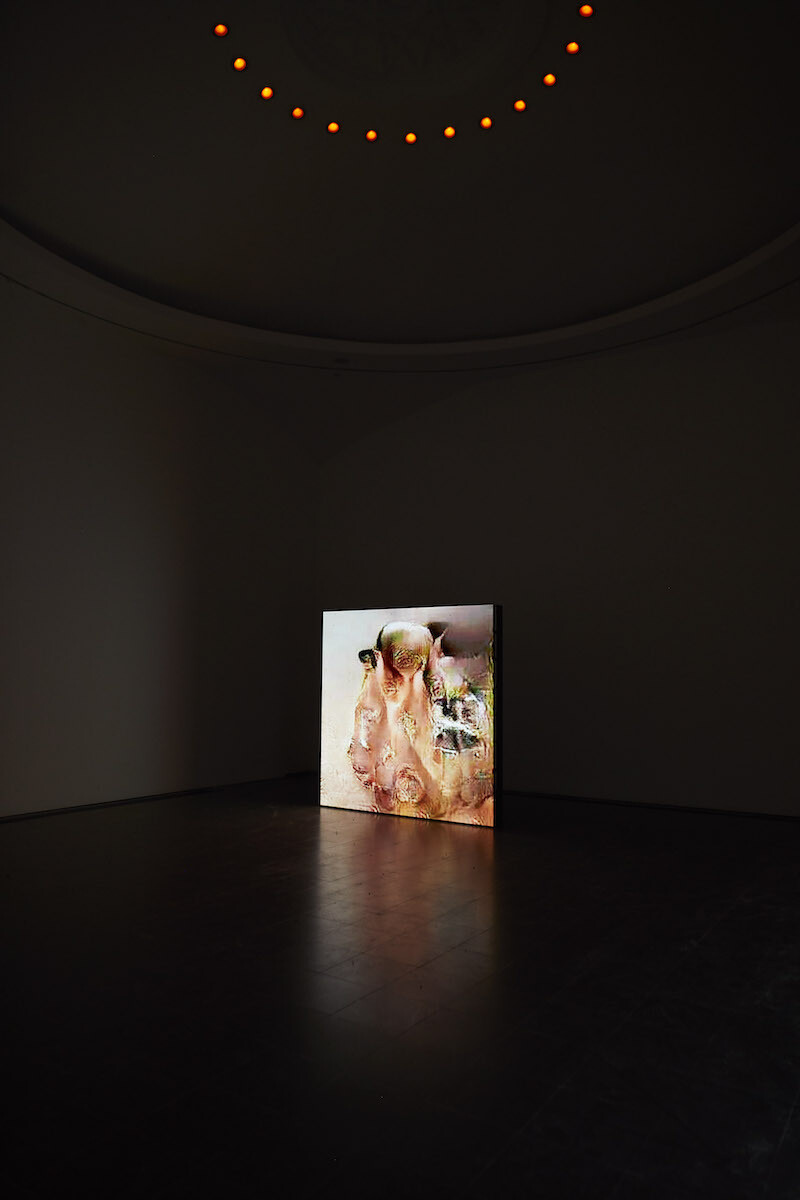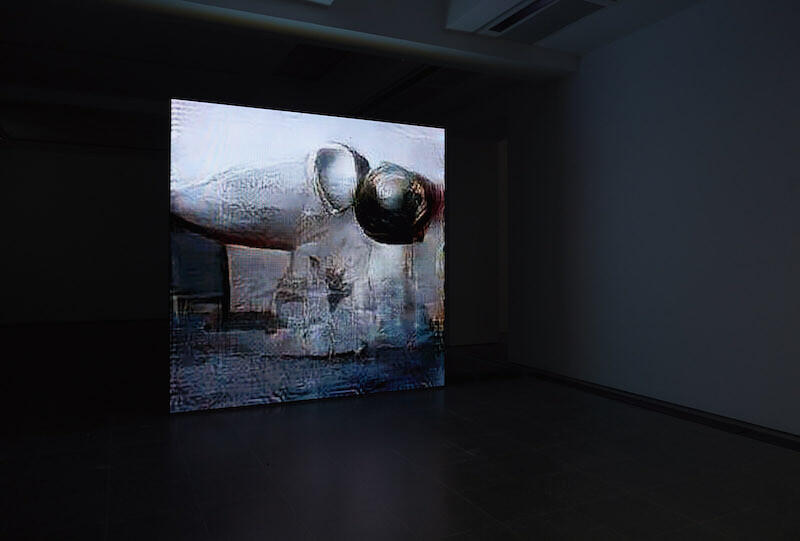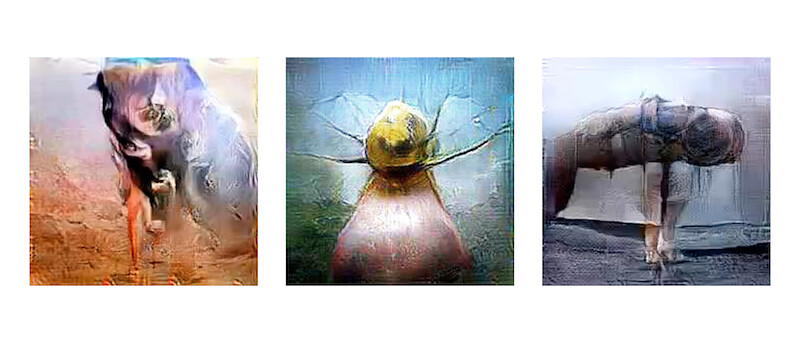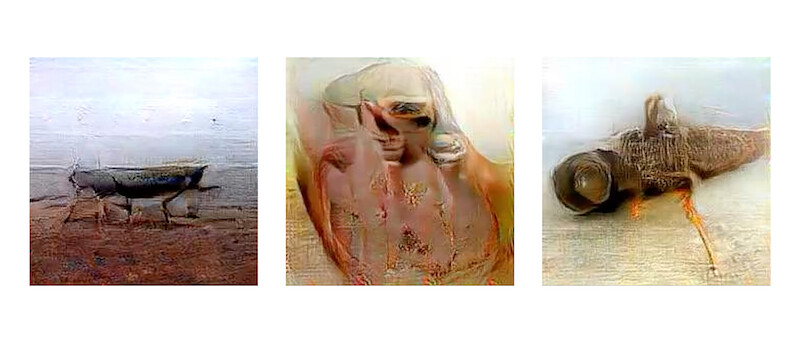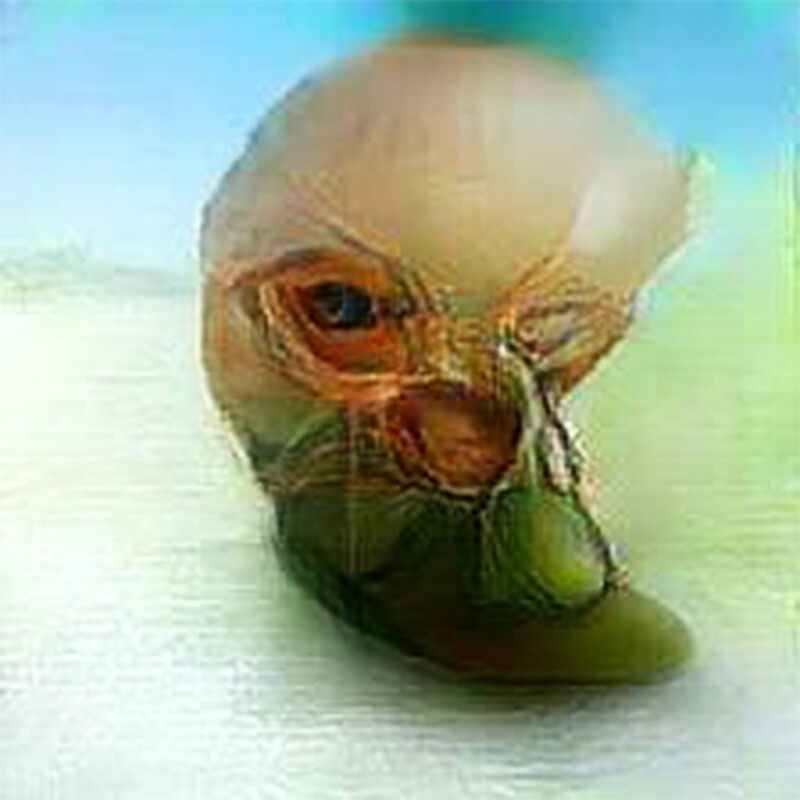Five large, freestanding LED panels fill the spaces of the Serpentine. Despite their technological nature, they look like temporary plaster walls and give the rooms a stripped appearance. Images scroll onscreen at high speed. In the darkened exhibition space, they have peculiar light and colors, cold and clear tones. Sounds can be heard, but like the shapes on the panels, I don’t know what they relate to: A microphone? A bird? Nothing corresponds to anything entirely; the sounds oscillate between machine, human, and animal. The same is true of the strange scent diffused in the air. Dust clings to viewers’ shoes. It will spread to the gardens, the streets, the tube. It comes from a large mural on the wall of the main room, a version of timekeeper (1999). Timekeeper is an archeology of the place, a mural that looks like the impression of the rings on a tree trunk, made by sanding down the wall of the exhibition space, each layer of exposed paint forming a different color circle. Here, the same sanding process is at play but it forms sinuous lines, like a map of an unknown territory. Flies roam overhead. They were born in the gallery’s ceiling, which is decorated with orange-tinted heat lamps that warm the room. At times, the images on the panels freeze. The rate of interruption depends on the conditions of the gallery space: temperature, humidity, and light. These vary based on the number of visitors, the weather outside, the birth of flies, and so on. It is an endless feedback loop between the environment and entities in motion.
“UUmwelt” is a logical continuation of projects like Untilled (2011–12, shown at Documenta 13 in 2012) and After ALife Ahead (Skulptur Projekte Münster, 2017). These are neither installations nor performances. They come close to a living organism, or what one could call complex systems. A colony of ants is a complex system, as is the stock exchange, Wikipedia, or the development of an embryo. All involve a dynamic mesh of entities (biotic and/or abiotic) whose behavior and retroaction cannot be predicted. “UUmwelt” is crafted like a complex system which plays with the museological archetypes of conservation—temperature, humidity, and light are captured and made interdependent with frozen frames and the proliferation of flies. It has a pulse, a rhythm (especially the frozen frames); it grows, dies, or gives birth following unpredictable conditions.
The screens present what Huyghe calls “mental images,” produced in a Japanese informatics lab called Kamitani Lab. Given a set of images by the artist, a person was instructed to imagine a situation while their brain waves were scanned; an artificial system of neurons then recomposed those mental images by drawing on a bank of preexisting images. What we see scrolling on the panels are not the final recomposed images but the search performed by the artificial intelligence employed at Kamitani. Our minds try to grasp bits of things; forms mix and hybridize in the chaotic order of insatiable research that doesn’t find what it is looking for. Sometimes a form seems to stabilize, but it then swells everywhere: a child’s face with dog ears, a car-bug hybrid, and so on. The images from Kamitani are delivered unedited: raw, plain, with scrambled lines, like sketches that haven’t yet found their finished form. It’s an atmosphere reminiscent of David Lynch or David Cronenberg, where fantasy becomes one with the biotic.
The technique employed at Kamitani may recall the practice of free association developed by Sigmund Freud. Moreover, the images bear striking resemblances to Surrealism, the sandy and evanescent forms of Salvador Dalí, Max Ernst, or Roberto Matta. Except here there’s no fantasy: a man imagines something and a machine recomposes his mental image. Is “UUmwelt” inviting us to rethink Surrealism—no longer as an artistic gesture locating an image beyond the real, but rather as the representation of a reality still in the making? The image is crawling, vibrating. It is a wild space, still uninformed by the rules of consciousness.
This realism is not new: Huyghe seeks to show the real rather than create fiction. In his 2011 work Umwelt, spiders and ants roved around Esther Schipper gallery in Berlin. At Documenta 13, there was the almost fantastic appearance of the dog Human (2012), with a leg dyed pink, while the chimera peacocks (who have a genetic mutation that means they have two sets of DNA) in After ALife Ahead were not altered by the artist at all. Nothing to transform; rather, the viewer is invited to observe those things that seem to humans like aberrations, deviations. Huyghe asks that we consider them differently: as facts composing a world that does not necessarily accord to logic.
The exhibition’s title, “UUmwelt,” refers to Estonian biologist Jakob von Uexküll’s theory of the Umwelt [environment]. Developed in the early twentieth century, it proposes that every species has a specific, unique way of perceiving its environment: a rat does not see as a bird or as a human, and so on. Each species’ divergent interpretation of signs leads to misunderstandings and sometimes to conflicts, to inconsistent and unforeseen situations. Worlding (the creation of an Umwelt) is a big step in AI life; it is at the core of many contemporary scientific attempts to understand its potential capacities. In the exhibition preceding Huyghe’s at the Serpentine, artist Ian Cheng presented a sentient artwork called BOB (Bag of Beliefs) (2018). BOB was an AI who inhabited the space, interacted with and learned from visitors. Through artificial imagination, Huyghe puts forward the idea, as does Cheng, that AI have their own Umwelt, as much as animals and humans do. AI, like any other sentient being, could have their own perception and imagination.
“UUmwelt” is located in the circulation between two separate worlds, the human and the artificial, which nowadays are getting closer and closer. Huyghe’s project does not bring near their fixed, complete meeting, as they have no perfect unity: images vibrate, they don’t match the originals. We can imagine that the path of their alliance could be like this proposition: made of abrupt associations, incessant research, incompatibilities, mutations, and births.
